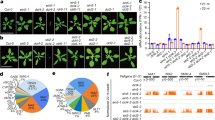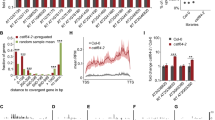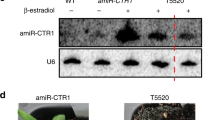Abstract
MicroRNAs (miRNAs) and short interfering RNAs (siRNAs), 20- to 27-nt in length, are essential regulatory molecules that act as sequence-specific guides in several processes in most eukaryotes (with the notable exception of the yeast Saccharomyces cerevisiae). These processes include DNA elimination, heterochromatin assembly, mRNA cleavage and translational repression. This review focuses on the regulatory roles of plant miRNAs during development, in the adaptive response to stresses and in the miRNA pathway itself. This review also covers the regulatory roles of two classes of endogenous plant siRNAs, ta-siRNAs and nat-siRNAs, which participate in post-transcriptional control of gene expression.
This is a preview of subscription content, access via your institution
Access options
Subscribe to this journal
Receive 12 print issues and online access
$209.00 per year
only $17.42 per issue
Buy this article
- Purchase on Springer Link
- Instant access to full article PDF
Prices may be subject to local taxes which are calculated during checkout



Similar content being viewed by others
References
Bartel, D.P. MicroRNAs: genomics, biogenesis, mechanism, and function. Cell 116, 281–297 (2004).
Ambros, V. The functions of animal microRNAs. Nature 431, 350–355 (2004).
Kim, V.N. Small RNAs: classification, biogenesis, and function. Mol. Cells 19, 1–15 (2005).
Du, T. & Zamore, P.D. microPrimer: the biogenesis and function of microRNA. Development 132, 4645–4652 (2005).
Lewis, B.P., Burge, C.B. & Bartel, D.P. Conserved seed pairing, often flanked by adenosines, indicates that thousands of human genes are microRNA targets. Cell 120, 15–20 (2005).
Baulcombe, D. RNA silencing in plants. Nature 431, 356–363 (2004).
Bao, N., Lye, K.W. & Barton, M.K. MicroRNA binding sites in Arabidopsis class III HD-ZIP mRNAs are required for methylation of the template chromosome. Dev. Cell 7, 653–662 (2004).
Chan, S.W., Henderson, I.R. & Jacobsen, S.E. Gardening the genome: DNA methylation in Arabidopsis thaliana. Nat. Rev. Genet. 6, 351–360 (2005).
Matzke, M.A., Matzke, A.J., Pruss, G.J. & Vance, V.B. RNA-based silencing strategies in plants. Curr. Opin. Genet. Dev. 11, 221–227 (2001).
Verdel, A. & Moazed, D. RNAi-directed assembly of heterochromatin in fission yeast. FEBS Lett. 579, 5872–5878 (2005).
Xie, Z. et al. Genetic and functional diversification of small RNA pathways in plants. PLoS Biol. 2, 642–652 (2004).
Akbergenov, R. et al. Molecular characterization of geminivirus-derived small RNAs in different plant species. Nucleic Acids Res. 34, 462–471 (2006).
Dunoyer, P. & Voinnet, O. The complex interplay between plant viruses and host RNA-silencing pathways. Curr. Opin. Plant Biol. 8, 415–423 (2005).
Pruss, G., Ge, X., Shi, X.M., Carrington, J.C. & Bowman Vance, V. Plant viral synergism: the potyviral genome encodes a broad-range pathogenicity enhancer that transactivates replication of heterologous viruses. Plant Cell 9, 859–868 (1997).
Vance, V. & Vaucheret, H. RNA silencing in plants—defense and counterdefense. Science 292, 2277–2280 (2001).
Napoli, C., Lemieux, C. & Jorgensen, R. Introduction of a chimeric chalcone synthase gene into Petunia results in reversible co-suppression of homologous genes in trans. Plant Cell 2, 279–289 (1990).
Allen, E., Xie, Z., Gustafson, A.M. & Carrington, J.C. microRNA-directed phasing during trans-acting siRNA biogenesis in plants. Cell 121, 207–221 (2005).
Gasciolli, V., Mallory, A.C., Bartel, D.P. & Vaucheret, H. Partially redundant functions of Arabidopsis DICER-like enzymes and a role for DCL4 in producing trans-acting siRNAs. Curr. Biol. 15, 1494–1500 (2005).
Peragine, A., Yoshikawa, M., Wu, G., Albrecht, H.L. & Poethig, R.S. SGS3 and SGS2/SDE1/RDR6 are required for juvenile development and the production of trans-acting siRNAs in Arabidopsis. Genes Dev. 18, 2368–2379 (2004).
Vazquez, F. et al. Endogenous trans-acting siRNAs regulate the accumulation of Arabidopsis mRNAs. Mol. Cell 16, 69–79 (2004).
Xie, Z., Allen, E., Wilken, A. & Carrington, J.C. DICER-LIKE 4 functions in trans-acting small interfering RNA biogenesis and vegetative phase change in Arabidopsis thaliana. Proc. Natl. Acad. Sci. USA 102, 12984–12989 (2005).
Yoshikawa, M., Peragine, A., Park, M.Y. & Poethig, R.S. A pathway for the biogenesis of trans-acting siRNAs in Arabidopsis. Genes Dev. 19, 2164–2175 (2005).
Borsani, O., Zhu, J., Verslues, P.E., Sunkar, R. & Zhu, J.K. Endogenous siRNAs derived from a pair of natural cis-antisense transcripts regulate salt tolerance in Arabidopsis. Cell 123, 1279–1291 (2005).
Chan, S.W. et al. RNA silencing genes control de novo DNA methylation. Science 303, 1336 (2004).
Lippman, Z. et al. Role of transposable elements in heterochromatin and epigenetic control. Nature 430, 471–476 (2004).
Bagga, S. et al. Regulation by let-7 and lin-4 miRNAs results in target mRNA degradation. Cell 122, 553–563 (2005).
Valencia-Sanchez, M.A., Liu, J., Hannon, G.J. & Parker, R. Control of translation and mRNA degradation by miRNAs and siRNAs. Genes Dev. 20, 515–524 (2006).
Wu, L., Fan, J. & Belasco, J.G. MicroRNAs direct rapid deadenylation of mRNA. Proc. Natl. Acad. Sci. USA 103, 4034–4039 (2006).
Yekta, S., Shih, I.H. & Bartel, D.P. MicroRNA-directed cleavage of HOXB8 mRNA. Science 304, 594–596 (2004).
Kurihara, Y. & Watanabe, Y. Arabidopsis microRNA biogenesis through Dicer-like 1 protein functions. Proc. Natl. Acad. Sci. USA 101, 12753–12758 (2004).
Kurihara, Y., Takashi, Y. & Watanabe, Y. The interaction between DCL1 and HYL1 is important for efficient and precise processing of pri-miRNA in plant microRNA biogenesis. RNA 12, 206–212 (2006).
Han, M.H., Goud, S., Song, L. & Fedoroff, N. The Arabidopsis double-stranded RNA-binding protein HYL1 plays a role in microRNA-mediated gene regulation. Proc. Natl. Acad. Sci. USA 101, 1093–1098 (2004).
Park, W., Li, J., Song, R., Messing, J. & Chen, X. CARPEL FACTORY, a Dicer homolog, and HEN1, a novel protein, act in microRNA metabolism in Arabidopsis thaliana. Curr. Biol. 12, 1484–1495 (2002).
Reinhart, B.J., Weinstein, E.G., Rhoades, M.W., Bartel, B. & Bartel, D.P. MicroRNAs in plants. Genes Dev. 16, 1616–1626 (2002).
Vazquez, F., Gasciolli, V., Crété, P. & Vaucheret, H. The nuclear dsRNA binding protein HYL1 is required for microRNA accumulation and plant development, but not posttranscriptional transgene silencing. Curr. Biol. 14, 346–351 (2004).
Yu, B. et al. Methylation as a crucial step in plant microRNA biogenesis. Science 307, 932–935 (2005).
Vaucheret, H., Vazquez, F., Crété, P. & Bartel, D.P. The action of ARGONAUTE1 in the miRNA pathway and its regulation by the miRNA pathway are crucial for plant development. Genes Dev. 18, 1187–1197 (2004).
Qi, Y., Denli, A.M. & Hannon, G.J. Biochemical specialization within Arabidopsis RNA silencing pathways. Mol. Cell 19, 421–428 (2005).
Baumberger, N. & Baulcombe, D.C. Arabidopsis ARGONAUTE1 is an RNA Slicer that selectively recruits microRNAs and short interfering RNAs. Proc. Natl. Acad. Sci. USA 102, 11928–11933 (2005).
Park, M.Y., Wu, G., Gonzalez-Sulser, A., Vaucheret, H. & Poethig, R.S. Nuclear processing and export of microRNAs in Arabidopsis. Proc. Natl. Acad. Sci. USA 102, 3691–3696 (2005).
Xie, Z., Kasschau, K.D. & Carrington, J.C. Negative feedback regulation of Dicer-Like1 in Arabidopsis by microRNA-guided mRNA. Curr. Biol. 13, 784–789 (2003).
Palatnik, J.F. et al. Control of leaf morphogenesis by microRNAs. Nature 425, 257–263 (2003).
Llave, C., Xie, Z., Kasschau, K.D. & Carrington, J.C. Cleavage of Scarecrow-like mRNA targets directed by a class of Arabidopsis miRNA. Science 297, 2053–2056 (2002).
Aukerman, M.J. & Sakai, H. Regulation of flowering time and floral organ identity by a microRNA and its APETALA2-like target genes. Plant Cell 15, 2730–2741 (2003).
Chen, X. A microRNA as a translational repressor of APETALA2 in Arabidopsis flower development. Science 303, 2022–2025 (2004).
Schwab, R. et al. Specific effects of microRNAs on the plant transcriptome. Dev. Cell 8, 517–527 (2005).
Jacobsen, S.E., Running, M.P. & Meyerowitz, E.M. Disruption of an RNA helicase/RNAse III gene in Arabidopsis causes unregulated cell division in floral meristems. Development 126, 5231–5243 (1999).
Lu, C. & Fedoroff, N. A mutation in the Arabidopsis HYL1 gene encoding a dsRNA binding protein affects responses to abscisic acid, auxin and cytokinin. Plant Cell 12, 2351–2366 (2000).
Telfer, A. & Poethig, R.S. HASTY: a gene that regulates the timing of shoot maturation in Arabidopsis thaliana. Development 125, 1889–1898 (1998).
Bohmert, K. et al. AGO1 defines a novel locus of Arabidopsis controlling leaf development. EMBO J. 17, 170–180 (1998).
Chen, X., Liu, J., Cheng, Y. & Jia, D. HEN1 functions pleiotropically in Arabidopsis development and acts in C function in the flower. Development 129, 1085–1094 (2002).
Kasschau, K.D. et al. P1/HC-Pro, a viral suppressor of RNA silencing, interferes with Arabidopsis development and miRNA function. Dev. Cell 4, 205–217 (2003).
Schauer, S.E., Jacobsen, S.E., Meinke, D.W. & Ray, A. DICER-LIKE1: blind men and elephants in Arabidopsis development. Trends Plant Sci. 7, 487–491 (2002).
Morel, J.B. et al. Fertile hypomorphic ARGONAUTE (ago1) mutants impaired in post-transcriptional gene silencing and virus resistance. Plant Cell 14, 629–639 (2002).
Lynn, K. et al. The PINHEAD/ZWILLE gene acts pleiotropically in Arabidopsis development and has overlapping functions with the ARGONAUTE1 gene. Development 126, 469–481 (1999).
Hiraguri, A. et al. Specific interactions between Dicer-like proteins and HYL1/DRB-family dsRNA-binding proteins in Arabidopsis thaliana. Plant Mol. Biol. 57, 173–188 (2005).
McConnell, J.R. et al. Role of PHABULOSA and PHAVOLUTA in determining radial patterning in shoots. Nature 411, 709–713 (2001).
Emery, J.F. et al. Radial patterning of Arabidopsis shoots by class III HD-ZIP and KANADI genes. Curr. Biol. 13, 1768–1774 (2003).
Rhoades, M.W. et al. Prediction of plant microRNA targets. Cell 110, 513–520 (2002).
Tang, G., Reinhart, B.J., Bartel, D.P. & Zamore, P.D. A biochemical framework for RNA silencing in plants. Genes Dev. 17, 49–63 (2003).
Mallory, A.C. et al. MicroRNA control of PHABULOSA in leaf development: importance of pairing to the microRNA 5′ region. EMBO J. 23, 3356–3364 (2004).
Kim, J. et al. microRNA-directed cleavage of ATHB15 mRNA regulates vascular development in Arabidopsis inflorescence stems. Plant J. 42, 84–94 (2005).
Williams, L., Grigg, S.P., Xie, M., Christensen, S. & Fletcher, J.C. Regulation of Arabidopsis shoot apical meristem and lateral organ formation by microRNA miR166g and its AtHD-ZIP target genes. Development 132, 3657–3668 (2005).
Baker, C.C., Sieber, P., Wellmer, F. & Meyerowitz, E.M. The early extra petals1 mutant uncovers a role for microRNA miR164c in regulating petal number in Arabidopsis. Curr. Biol. 15, 303–315 (2005).
Guo, H.S., Xie, Q., Fei, J.F. & Chua, N.H. microRNA164 directs NAC1 mRNA cleavage to downregulate auxin signals for lateral root development. Plant Cell 17, 1376–1386 (2005).
Mallory, A.C., Dugas, D.V., Bartel, D.B. & Bartel, B. MicroRNA regulation of NAC-domain targets is required for proper formation and separation of adjacent embryonic, vegetative and floral organs. Curr. Biol. 14, 1035–1046 (2004).
Achard, P., Herr, A., Baulcombe, D.C. & Harberd, N.P. Modulation of floral development by a gibberellin-regulated microRNA. Development 131, 3357–3365 (2004).
Wang, J.W. et al. Control of root cap formation by microRNA-targeted auxin response factors in Arabidopsis. Plant Cell 17, 2204–2216 (2005).
Laufs, P., Peaucelle, A., Morin, H. & Traas, J. MicroRNA regulation of the CUC genes is required for boundary size control in Arabidopsis meristems. Development 131, 4311–4322 (2004).
Millar, A.A. & Gubler, F. The Arabidopsis GAMYB-like genes, MYB33 and MYB65, are microRNA-regulated genes that redundantly facilitate anther development. Plant Cell 17, 705–721 (2005).
Mallory, A.C., Bartel, D.P. & Bartel, B. MicroRNA-directed regulation of Arabidopsis AUXIN RESPONSE FACTOR17 is essential for proper development and modulates expression of early auxin response genes. Plant Cell 17, 1360–1375 (2005).
Sunkar, R. & Zhu, J.K. Novel and stress-regulated microRNAs and other small RNAs from Arabidopsis. Plant Cell 16, 2001–2019 (2004).
Jones-Rhoades, M.W. & Bartel, D.P. Computational identification of plant miRNAs and their targets, including a stress-induced miRNA. Mol. Cell 14, 787–799 (2004).
Chiou, T.J. et al. Regulation of phosphate homeostasis by microRNA in Arabidopsis. Plant Cell 18, 412–421 (2006).
Fujii, H., Chiou, T.J., Lin, S.I., Aung, K. & Zhu, J.K. A miRNA involved in phosphate-starvation response in Arabidopsis. Curr. Biol. 15, 2038–2043 (2005).
Lu, S. et al. Novel and mechanical stress-responsive microRNAs in Populus trichocarpa that are absent from Arabidopsis. Plant Cell 17, 2186–2203 (2005).
Wang, X.J., Gaasterland, T. & Chua, N.H. Genome-wide prediction and identification of cis-natural antisense transcripts in Arabidopsis thaliana. Genome Biol. 6, R30 (2005).
Lecellier, C.H. et al. A cellular microRNA mediates antiviral defense in human cells. Science 308, 557–560 (2005).
Jopling, C.L., Yi, M., Lancaster, A.M., Lemon, S.M. & Sarnow, P. Modulation of hepatitis C virus RNA abundance by a liver-specific microRNA. Science 309, 1577–1581 (2005).
Takeda, A. et al. A plant RNA virus suppresses RNA silencing through viral RNA replication. EMBO J. 24, 3147–3157 (2005).
Dunoyer, P., Himber, C. & Voinnet, O. Induction, suppression and requirement of RNA silencing pathways in virulent Agrobacterium tumefaciens infections. Nat. Genet. 38, 258–263 (2006).
Llave, C. MicroRNAs: more than a role in plant development? Mol. Plant Pathol. 5, 361–366 (2004).
Li, H.W. & Ding, S.W. Antiviral silencing in animals. FEBS Lett. 579, 5965–5973 (2005).
Simon-Mateo, C. & Garcia, J.A. MicroRNA-guided processing impairs Plum pox virus replication, but the virus readily evolves to escape this silencing mechanism. J. Virol. 80, 2429–2436 (2006).
Mallory, A.C., Reinhart, B.J., Bartel, D., Vance, V.B. & Bowman, L.H. A viral suppressor of RNA silencing differentially regulates the accumulation of short interfering RNAs and micro-RNAs in tobacco. Proc. Natl. Acad. Sci. USA 99, 15228–15233 (2002).
Chapman, E.J., Prokhnevsky, A.I., Gopinath, K., Dolja, V.V. & Carrington, J.C. Viral RNA silencing suppressors inhibit the microRNA pathway at an intermediate step. Genes Dev. 18, 1179–1186 (2004).
Dunoyer, P., Lecellier, C.H., Parizotto, E.A., Himber, C. & Voinnet, O. Probing the microRNA and small interfering RNA pathways with virus-encoded suppressors of RNA silencing. Plant Cell 16, 1235–1250 (2004).
Vaucheret, H., Mallory, A.C. & Bartel, D.P. AGO1 homeostasis entails coexpression of miR168 and AGO1 and preferential stabilization of miR168 by AGO1. Mol. Cell 22, 129–136 (2006).
Brennecke, J. & Cohen, S.M. Towards a complete description of the microRNA complement of animal genomes. Genome Biol. 4, 228 (2003).
Krek, A. et al. Combinatorial microRNA target predictions. Nat. Genet. 37, 495–500 (2005).
Farh, K.K. et al. The widespread impact of mammalian microRNAs on mRNA repression and evolution. Science 310, 1817–1821 (2005).
Stark, A., Brennecke, J., Bushati, N., Russell, R.B. & Cohen, S.M. Animal microRNAs confer robustness to gene expression and have a significant impact on 3′ UTR evolution. Cell 123, 1133–1146 (2005).
Jones-Rhoades, M.W., Bartel, D.P. & Bartel, B. MicroRNAs and their regulatory roles in plants. Annu. Rev. Plant Biol. published online 30 January 2006 (doi:10.1146/annurev.arplant.57.032905.105218).
Lu, C. et al. Elucidation of the small RNA component of the transcriptome. Science 309, 1567–1569 (2005).
Gustafson, A.M. et al. ASRP: the Arabidopsis small RNA project database. Nucleic Acids Res. 33, D637–D640 (2005).
Acknowledgements
We thank D. Bartel and members of the Vaucheret and Bartel labs for fruitful discussions. Work in the Vaucheret laboratory is supported by the Institut National de la Recherche Agronomique (INRA) and the European Commission (Riboreg program). A.C.M. is supported by a US National Institutes of Health Postdoctoral Training Fellowship.
Author information
Authors and Affiliations
Corresponding author
Ethics declarations
Competing interests
The authors declare no competing financial interests.
Rights and permissions
About this article
Cite this article
Mallory, A., Vaucheret, H. Functions of microRNAs and related small RNAs in plants. Nat Genet 38 (Suppl 6), S31–S36 (2006). https://doi.org/10.1038/ng1791
Published:
Issue Date:
DOI: https://doi.org/10.1038/ng1791
This article is cited by
-
Evaluating the causal association between microRNAs and amyotrophic lateral sclerosis
Neurological Sciences (2023)
-
Construction and application of star polycation nanocarrier-based microRNA delivery system in Arabidopsis and maize
Journal of Nanobiotechnology (2022)
-
Increased rates of gene-editing events using a simplified RNAi configuration designed to reduce gene silencing
Plant Cell Reports (2022)
-
DNAzyme signal amplification based on Au@Ag core–shell nanorods for highly sensitive SERS sensing miRNA-21
Analytical and Bioanalytical Chemistry (2022)
-
Small RNAs and their targets are associated with the transgenerational effects of water-deficit stress in durum wheat
Scientific Reports (2021)



